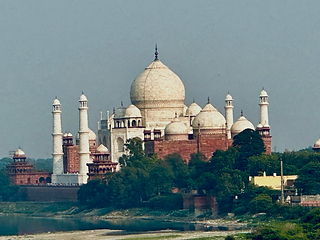The Golden Triangle - Northern India



Northern India
In Delhi we joined a small group tour for the rest of our travels in India. In the north, we were to explore the Golden Triangle - Agra, Ranthambore National Park, Jaipur and Delhi, followed by a few days in Varanasi. This area offers a rich tapestry of cultural experiences. Agra's iconic Taj Mahal, Ranthambore’s wildlife and natural beauty, Jaipur's vibrant markets and palaces, and Delhi's historic monuments, collectively create a captivating journey through India's history and architecture. Varanasi holds immense cultural and religious significance in Hinduism. The contrasts between bustling city life, serene landscapes, intricate palatial designs and a revered spiritual city were fascinating.
Agra Fort and the Taj Mahal stand as architectural marvels, each narrating a unique chapter in history. Agra Fort's red sandstone magnificence, built in the mid 16th century to protect the capital city of Agra, showcases Mughal strength and grandeur while the Taj Mahal, a white-marble masterpiece, built in the mid 17th century, epitomizes eternal love. The ivory marble mausoleum, commissioned by Shah Jahan, a Mughal emperor for his beloved third wife, is an amazing example of indo islamic architecture. While his wife is buried there, he was never able to visit because he was deposed by his son and imprisoned until he died. Exploring the intricate chambers of Agra Fort and witnessing the Taj Mahal’s beauty at sunrise intertwines history, art, and romance.
While in Agra, we headed into the night markets for street food dinner. It was a lively colorful bustling market with lots of vendors selling tasty bites cooked on giant woks then served on banana leaves - so many delicious flavors and way too much to eat!
This trip involved a fair amount of driving as the distances between cities were fairly significant. As we left the cities behind, we passed through small villages with markets along the street selling everything from fresh fruits and vegetables to clothing. All manner of transportation traveled the local roads - 3 wheel tuk tuks, bicycles, mules, tractors and even the occasional camel. Cows were ubiquitous and had the right of way.






Ranthambore National Park
After Agra, we headed to Ranthambore National Park in search of the elusive Bengal tigers. This picturesque park is home to many other wild animals as well. We saw a gaur, a few different kinds of deer, a wooly necked stork, langur monkeys and too many birds to mention. We did finally find a tiger, mostly snoozing but we were among the lucky ones to see one at all.

Jaipur
Jaipur’s palaces, including the Hawa Mahal, City Palace, and Jal Mahal, unveil the regal splendor of the Pink City. The intricate architecture, ornate details, and vibrant colors transport you to a bygone era of Rajput royalty. Exploring the opulent rooms, courtyards, and gardens within these palaces provides a glimpse into the lavish lifestyle of the Maharajas. Jaipur’s palaces offer a captivating blend of history and architectural opulence.
On a free afternoon, Betsey got a henna tattoo known as mehndi. Intricate designs including an elephant, peacocks and flowers were created using paste from henna leaves. The results were beautiful!

Varanasi
In Varanasi, the dawn ceremony performed by priests along the Ganges River is a mesmerizing spectacle. The rhythmic chants, the fragrance of incense, and the flickering oil lamps create a spiritual ambiance as priests offer prayers to the rising sun. The pre-dawn ceremony we watched was a serene and culturally immersive way to begin the day.
Varanasi is, for hindus, the most holy water in India. Many people make a pilgrimage to soak themselves in the water. It is a source for bathing, washing and celebrating. It is also a place to be cremated and buried. There are two main Ghats lining the riverbanks hosting rituals, ceremonies, and spiritual activities. Cremations occur all day long. Before the actual cremation, there are spiritual activities to ensure safe passage to reincarnation.
Exploring the waterfront on foot and by boat provided a good view of its cultural significance. We also saw how much the Ganges flooded every year. There were men washing 3-4 ft of clay back into the river after the end of the rainy season!

Delhi
We ended our northern adventure back in Delhi, with its dynamic blend of history and modernity. The city landmarks include the Red Fort, India Gate, and Qutub Minar, reflecting diverse architectural styles.
In Chandni Chowk, we saw the bustling markets along with a festive parade. We visited India’s oldest and largest mosque. In order to visit a mosque, everyone removes their shoes. We had a bit of excitement when we came out because my shoes were missing! Fortunately we were able to exchange them with a man who was probably trying to figure out why his shoes suddenly didn’t fit. No harm, no foul. We visited a Sikh temple with its large community kitchen serving free meals to all. The temple was a peaceful retreat and a glimpse into the Sikh culture.























































